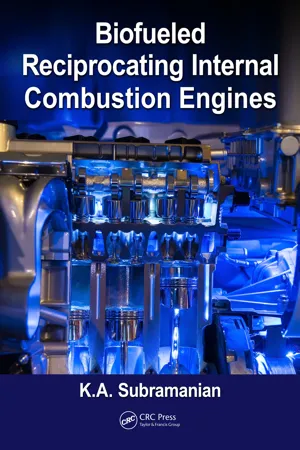
Biofueled Reciprocating Internal Combustion Engines
K.A. Subramanian
- 262 pages
- English
- ePUB (mobile friendly)
- Available on iOS & Android
Biofueled Reciprocating Internal Combustion Engines
K.A. Subramanian
About This Book
Biofuels such as ethanol, butanol, and biodiesel have more desirable physico-chemical properties than base petroleum fuels (diesel and gasoline), making them more suitable for use in internal combustion engines. The book begins with a comprehensive review of biofuels and their utilization processes and culminates in an analysis of biofuel quality and impact on engine performance and emissions characteristics, while discussing relevant engine types, combustion aspects and effect on greenhouse gases. It will facilitate scattered information on biofuels and its utilization has to be integrated as a single information source. The information provided in this book would help readers to update their basic knowledge in the area of "biofuels and its utilization in internal combustion engines and its impact Environment and Ecology". It will serve as a reference source for UG/PG/Ph.D. Doctoral Scholars for their projects / research works and can provide valuable information to Researchers from Academic Universities and Industries.
Key Features:
• Compiles exhaustive information of biofuels and their utilization in internal combustion engines.
• Explains engine performance of biofuels
• Studies impact of biofuels on greenhouse gases and ecology highlighting integrated bio-energy system.
• Discusses fuel quality of different biofuels and their suitability for internal combustion engines.
• Details effects of biofuels on combustion and emissions characteristics.
Frequently asked questions
Information
1Introduction to Biofuels
1.1Overview of Fossil Fuels


Table of contents
- Cover
- Half Title Page
- Title Page
- Copyright Page
- Contents
- Preface
- Acknowledgments
- Author
- List of Symbols and Abbreviations
- Chapter 1 Introduction to Biofuels
- Chapter 2 Production of Biofuels
- Chapter 3 Biofuel Quality for Internal Combustion Engines
- Chapter 4 Introduction to Internal Combustion Engines
- Chapter 5 Basic Processes of Internal Combustion Engines
- Chapter 6 Utilization of Biofuels in Spark-Ignition Engines
- Chapter 7 Utilization of Biofuels in Compression-Ignition Engines
- Chapter 8 Biofueled Reactivity Controlled Compression-Ignition Engines
- Chapter 9 Effect of Biofuels on GHGs
- Chapter 10 Answers to Frequently Asked Questions
- Index
